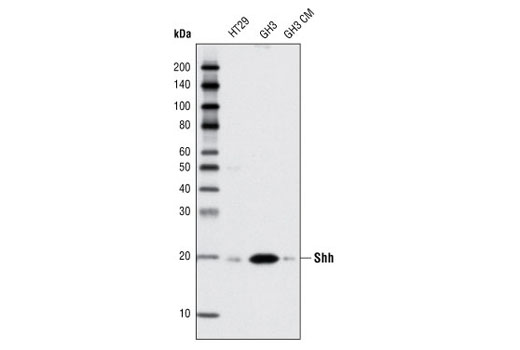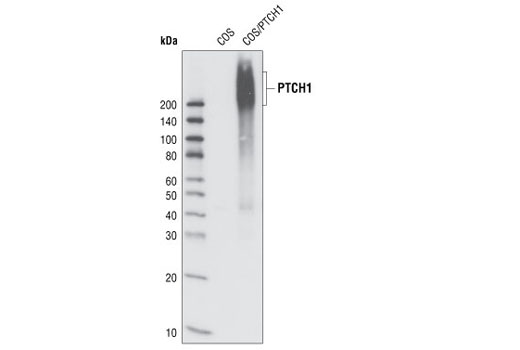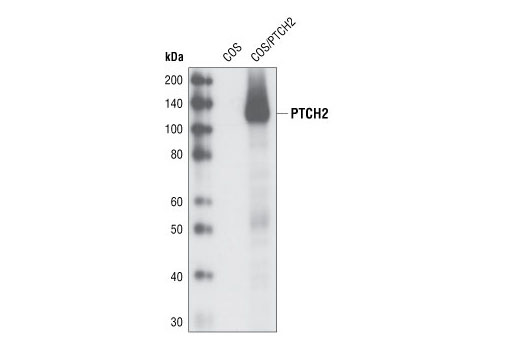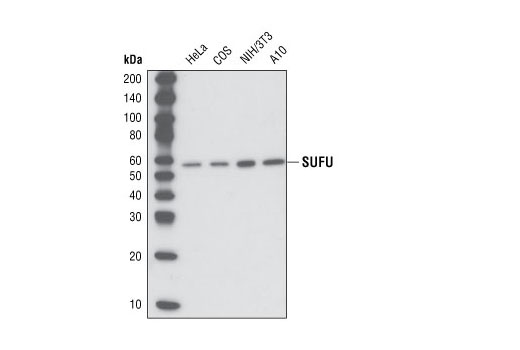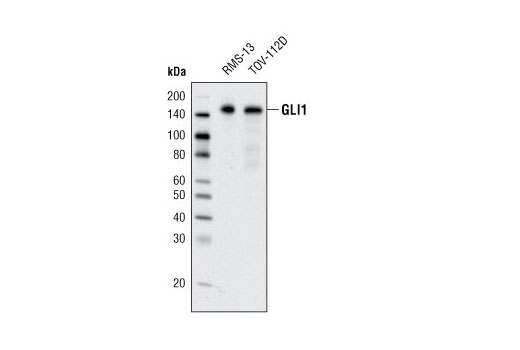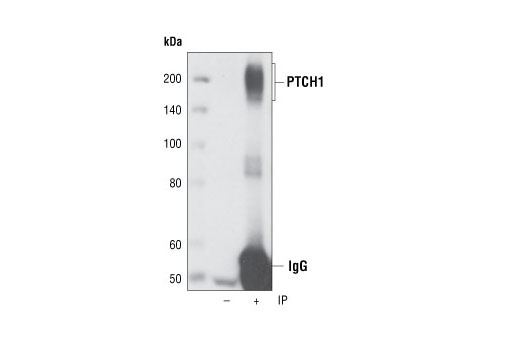| Product Includes | Product # | Quantity | Mol. Wt | Isotype/Source |
|---|---|---|---|---|
| Shh (C9C5) Rabbit mAb | 2207 | 20 µl | 19, (45 precursor) kDa | Rabbit IgG |
| PTCH1 (C53A3) Rabbit mAb | 2468 | 20 µl | 180-210 kDa | Rabbit IgG |
| PTCH2 (G1191) Antibody | 2470 | 20 µl | 130 kDa | Rabbit |
| SUFU (C54G2) Rabbit mAb | 2520 | 20 µl | 54 kDa | Rabbit IgG |
| GLI1 (C68H3) Rabbit mAb | 3538 | 20 µl | 160 kDa | Rabbit IgG |
| Anti-rabbit IgG, HRP-linked Antibody | 7074 | 100 µl | Goat |
Please visit cellsignal.com for individual component applications, species cross-reactivity, dilutions, protocols, and additional product information.
Description
This sampler kit provides an economical means of evaluating key members of the Hedgehog signaling pathway. The kit contains enough primary and secondary antibody to perform two western miniblot experiments.
Storage
Background
The evolutionarily conserved Hedgehog (Hh) signaling pathway plays critical roles in the regulation of patterning, growth, and cell migration during embryonic development and adult tissue homeostasis. Aberrant Hh signaling activity can be associated with numerous birth defects and uncontrolled Hh pathway activation is linked to the development of several types of cancers (1-2). The three identified vertebrate Hh genes are Sonic (Shh), Indian (Ihh), and Desert (Dhh), all of which have distinct as well as overlapping roles (3-5). Patched1 and 2 (PTCH1 and PTCH2) are twelve-pass transmembrane proteins that function as the Hh receptors (6-9). The general organization of the Hh pathway consists of a series of repressive interactions. In the absence of Hh proteins (off-state), PTCH suppresses the otherwise constitutively active signaling receptor Smoothened (Smo) (1,2). In the off-state, SUFU (Suppressor of Fused), originally identified in Drosophila as a suppressor of the Fused (Fu) kinase (10), suppresses Hh signaling by regulating the localization of the transcription factors Gli and Ci (11,12). In Drosophila, SUFU may also positively regulate Hh signaling depending on SUFU protein levels and Hh signal intensity (13).
- Ingham, P.W. and McMahon, A.P. (2001) Genes Dev 15, 3059-87.
- McMahon, A.P. et al. (2003) Curr Top Dev Biol 53, 1-114.
- Zhang, X.M. et al. (2001) Cell 106, 781-92.
- Adolphe, C. et al. (2004) Development 131, 5009-19.
- Pathi, S. et al. (2001) Mech Dev 106, 107-17.
- Stone, D.M. et al. (1996) Nature 384, 129-34.
- Chen, Y. and Struhl, G. (1996) Cell 87, 553-63.
- Motoyama, J. et al. (1998) Nat Genet 18, 104-6.
- Smyth, I. et al. (1999) Hum Mol Genet 8, 291-7.
- Pham, A. et al. (1995) Genetics 140, 587-98.
- Barnfield, P.C. et al. (2005) Differentiation 73, 397-405.
- Méthot, N. and Basler, K. (2000) Development 127, 4001-10.
- Dussillol-Godar, F. et al. (2006) Dev Biol 291, 53-66.
Background References
Trademarks and Patents
Limited Uses
Except as otherwise expressly agreed in a writing signed by a legally authorized representative of CST, the following terms apply to Products provided by CST, its affiliates or its distributors. Any Customer's terms and conditions that are in addition to, or different from, those contained herein, unless separately accepted in writing by a legally authorized representative of CST, are rejected and are of no force or effect.
Products are labeled with For Research Use Only or a similar labeling statement and have not been approved, cleared, or licensed by the FDA or other regulatory foreign or domestic entity, for any purpose. Customer shall not use any Product for any diagnostic or therapeutic purpose, or otherwise in any manner that conflicts with its labeling statement. Products sold or licensed by CST are provided for Customer as the end-user and solely for research and development uses. Any use of Product for diagnostic, prophylactic or therapeutic purposes, or any purchase of Product for resale (alone or as a component) or other commercial purpose, requires a separate license from CST. Customer shall (a) not sell, license, loan, donate or otherwise transfer or make available any Product to any third party, whether alone or in combination with other materials, or use the Products to manufacture any commercial products, (b) not copy, modify, reverse engineer, decompile, disassemble or otherwise attempt to discover the underlying structure or technology of the Products, or use the Products for the purpose of developing any products or services that would compete with CST products or services, (c) not alter or remove from the Products any trademarks, trade names, logos, patent or copyright notices or markings, (d) use the Products solely in accordance with CST Product Terms of Sale and any applicable documentation, and (e) comply with any license, terms of service or similar agreement with respect to any third party products or services used by Customer in connection with the Products.
